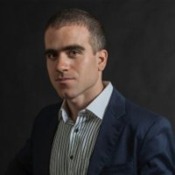Program Information
Vendor-Independent, Model-Based Iterative Reconstruction On a Rotating Grid with Coordinate-Descent Optimization for CT Imaging Investigations
S Young1*, J Hoffman1 , F Noo2 , M McNitt-Gray1 , (1) UCLA School of Medicine, Los Angeles, CA, (2) University of Utah, Salt Lake City, UT,
Presentations
SU-F-I-49 (Sunday, July 31, 2016) 3:00 PM - 6:00 PM Room: Exhibit Hall
Purpose: Iterative reconstruction methods show promise for improving image quality and lowering the dose in helical CT. We aim to develop a novel model-based reconstruction method that offers potential for dose reduction with reasonable computation speed and storage requirements for vendor-independent reconstruction from clinical data on a normal desktop computer.
Methods: In 2012, Xu proposed reconstructing on rotating slices to exploit helical symmetry and reduce the storage requirements for the CT system matrix. Inspired by this concept, we have developed a novel reconstruction method incorporating the stored-system-matrix approach together with iterative coordinate-descent (ICD) optimization. A penalized-least-squares objective function with a quadratic penalty term is solved analytically voxel-by-voxel, sequentially iterating along the axial direction first, followed by the transaxial direction. 8 in-plane (transaxial) neighbors are used for the ICD algorithm. The forward problem is modeled via a unique approach that combines the principle of Joseph’s method with trilinear B-spline interpolation to enable accurate reconstruction with low storage requirements. Iterations are accelerated with multi-CPU OpenMP libraries. For preliminary evaluations, we reconstructed (1) a simulated 3D ellipse phantom and (2) an ACR accreditation phantom dataset exported from a clinical scanner (Definition AS, Siemens Healthcare). Image quality was evaluated in the resolution module.
Results: Image quality was excellent for the ellipse phantom. For the ACR phantom, image quality was comparable to clinical reconstructions and reconstructions using open-source FreeCT_wFBP software. Also, we did not observe any deleterious impact associated with the utilization of rotating slices. The system matrix storage requirement was only 4.5GB, and reconstruction time was 50 seconds per iteration.
Conclusion: Our reconstruction method shows potential for furthering research in low-dose helical CT, in particular as part of our ongoing development of an acquisition/reconstruction pipeline for generating images under a wide range of conditions. Our algorithm will be made available open-source as “FreeCT_ICD”.
Funding Support, Disclosures, and Conflict of Interest: Funding support: NIH U01 CA181156 Disclosures (McNitt-Gray): Institutional research agreement, Siemens Healthcare Past recipient, research grant support, Siemens Healthcare Consultant, Toshiba America Medical Systems Consultant, Samsung Electronics
Contact Email:

